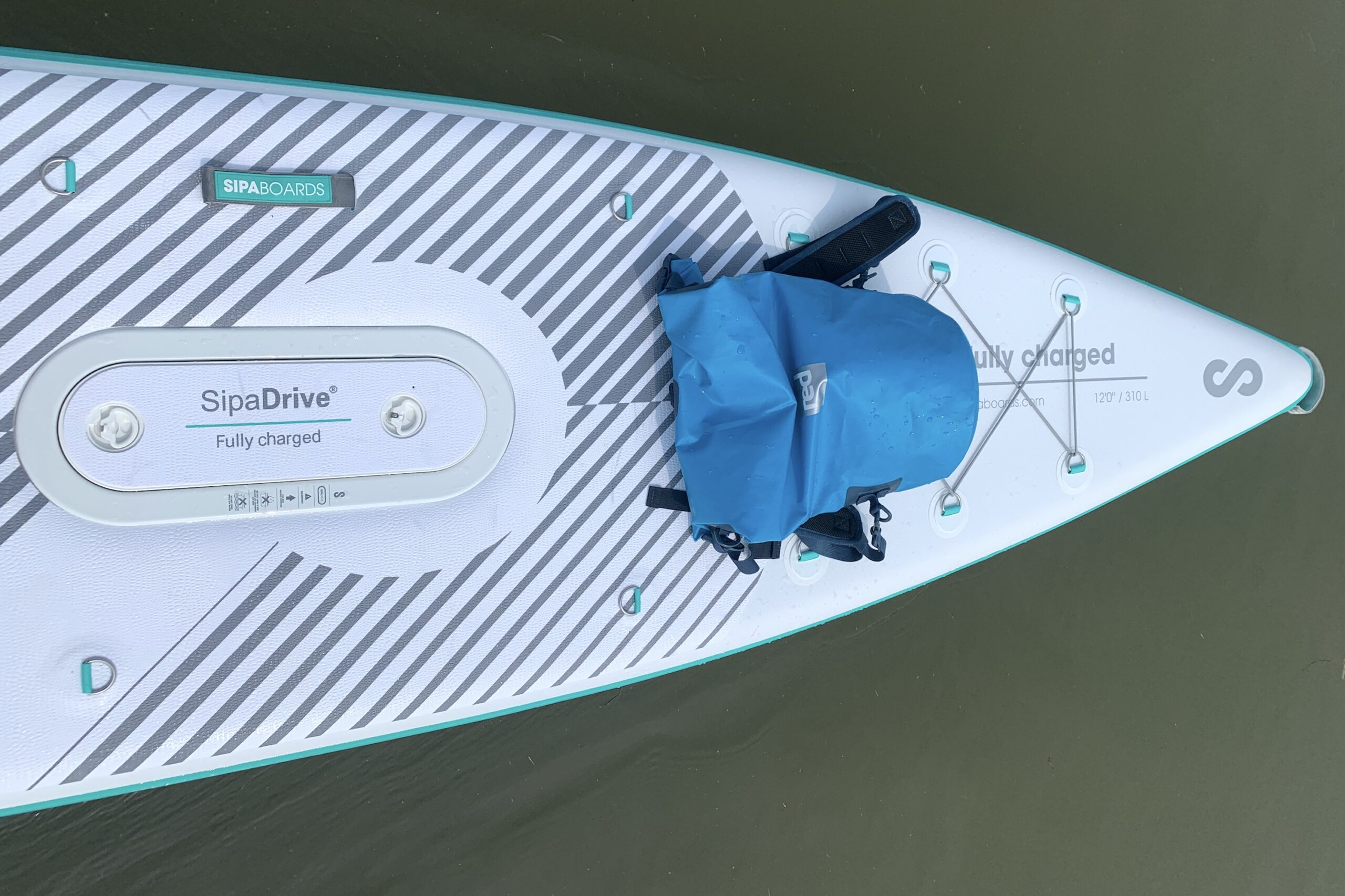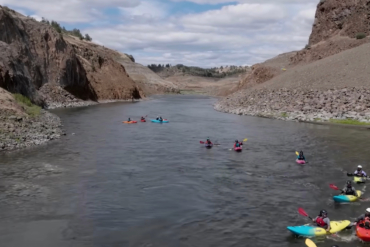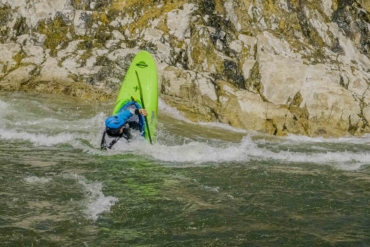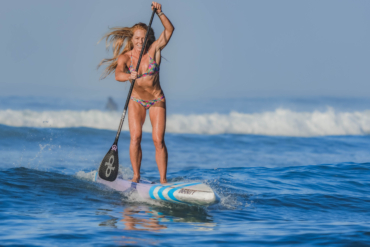There are very, very few electric standup paddleboards (e-SUPs) on the market. I’d equate it to the e-bike market 10 years ago. Right now, the SUP community at large wonders if e-SUPs are a gimmick or a true innovation.
To me, the concept of e-SUPs appears to be a little of both. As GearJunkie’s lead paddlesports editor, it’s pretty cool to be an expert in a category when a new trend arises. But it requires that I remain skeptical — will this trend pick up steam? Does it provide a solution to a common problem? Do the technical benefits outweigh the drawbacks? And, who’s it most going to serve?
While the jury is still out for e-SUPs at large, the execution and design of one brand in particular could maybe, just maybe, rival traditional paddleboards.
In short: SUPs with an electric motor and propeller sound cool. And they are — but also, they’re not. After putting in some testing, I concluded that e-SUPs are decidedly not the next best thing. At least, not for me. I test “drove” two of the newest e-SUPs on the market from SipaBoards. Here’s my verdict on these Sipa e-SUPs, and some feedback to help you decide if an e-SUP is right for you.
Read The Best Standup Paddleboards buyer’s guide.
SipaBoards Paddleboards: Electric SUP Review

SipaBoards was ahead of the curve when it comes to electric SUPs. The brand was founded back in 2015, although with a rudimentary model of the board it has now. In 2022, SipaBoards debuted four new models. I tested two of the four new models this spring: the SipaDrive Allrounder (11-foot) and the Tourer (12-foot).
First, a couple of notes on the concept. Again, just like e-bikes, e-SUPs are designed and marketed to provide an assist when paddling, whether you are a kid, a beginner, an adaptive paddler with limited mobility, or maybe just someone battling a fierce headwind. That extra push from a small propeller really helps.
Although most SUPs on the market that are trying to jump on this new “trend” aren’t actually designed from the bottom up to be an e-device, per se; they simply add or retrofit a motor or propeller onto the existing SUP or its fin.
There are a couple of really unique components that set SipaBoards apart from others trying to build e-SUPs.

First, the “e” function — battery pack and propeller — is separate from the fin and rest of the board. The unit is self-contained in the center of the board, and if you don’t turn it on, you are still able to paddle the SUP like normal.
It doesn’t alter the configuration of the board and fin. It doesn’t contribute any (or much) drag that I noticed. There are a couple of other SUP brands adding motors and propellers to their paddleboards, but they add these devices directly into the fin. Some of these devices are called “power fins” or “jet packs.” Many of them are heavy and require hardware to attach to an existing fin or board. And, the board won’t paddle normally, manually, with these devices attached.
Second, SipaBoards are self-inflating, which, I can confirm, is as cool as it sounds. Essentially, the battery pack that runs the propeller also inflates the SUP. No external manual or electric pump is required.
It has the same decibel level as electric pumps that plug into an external power source (like the 5V in your car). But with the self-inflating SipaBoard, you don’t have to be near your vehicle to inflate. The downside is it’s another thing in life you need to charge (each of the two battery packs) that power the SipaBoards.
And, using the same battery to inflate the SUP drains some of the battery off the bat — meaning, less power assist for later.

I spent a lot of time thinking about these two components. Are they pros, cons, both? From a design standpoint, the SipaBoards are super-dialed. If you are already bringing the extra weight of a battery pack for power assist, it may as well serve a dual function.
In the reverse, if you are someone who already opts to choose to bring along an electric pump, why not go fully electric with this upgrade?
Testing a SipaBoards E-SUP

I tested two models, but mainly the Allrounder model. The board is only 22 pounds, pretty competitive compared to similar size boards. But when you add the battery pack and motor unit, it bumps up to 33 pounds — too much for some to carry on their own, or carry very far.
I also tested the touring model, which was most fun for me on the water in terms of the feel when paddling. With both models, though, once the power assist kicks in, it’s a whole different experience.
On both, the battery packs and propeller are hidden under a sort of hatch that’s punched in the center of the board. You simply charge the batteries, drop them in, turn them on, and secure the cover.
The material of the Sipa e-SUPs (double-layer mono structural laminate with a drop-stitch core and reinforced on the rails) is also of higher quality. With any SUP, you’ll want to avoid single-layer construction and woven fabric. Ideally, the board is dual layer with a thicker weight of drop-stitch fabric, and reinforced and welded rails.
It’s worth noting it was also pretty awesome not having to inflate my board manually. It’s not fully automatic, as you have to drop the battery pack into the slot on the board, and adjust between the first and second stages as it pumps.
But otherwise, it’s a seamless process that allows you to stand around, admire the nice weather, chat, and have a drink with friends. Or, help the kids don their PFDs, or spend that time packing up other gear. In terms of efficiency in getting on the water, the SipaBoard is pretty good.
E-SUP Power Assist: Does It Make a Difference?

So, how fast will these 90Wh (a total of 180Wh with two) lithium-ion battery blocks really let you go? SipaBoards claims up to 3 knots (4 mph)…which isn’t very fast. But I wanted to find out, for the same reason that all of you are thinking, “Why the heck would I want to invest in a $2,000 electric SUP?” (Arguably, for the same reason you’d want to invest $700-1,000 in a standard SUP: fun.)
On my first demo day with the Sipa Allrounder paddleboard, I picked a 200-yard section of our local lake with two markers on land, and then paddled between them (point A to point B) in the same direction for accuracy.
To be honest, I didn’t feel a ton of assist on level 1 (yes, the motor is on, but it will feel like a crawl if you aren’t also paddling). So, for the purpose of testing out the speed and “fun factor,” I completed this time test on levels 2 and 3. And, I tried to paddle at roughly 50% effort to emulate the leisurely speed of a recreational paddler.
- On level 2, it took me 1 minute, 49 seconds
- On level 3, it took me 1 minute, 38 seconds
- Paddling unassisted with the e-SUP off, it took me about 3 minutes

Best of all, over the course of a couple of hours, I didn’t notice any drops in the bars indicating battery life (indicated on the paddle remote with a series of lights), even after zipping around on level 3 for about an hour.
However, SipaBoards does advertise that if you are using level 3 the entire time, it will drain the battery more quickly. The other function that will drain the battery more quickly is actually inflating the SUP to the needed psi before you get out on the water. The approximate battery life with two fully charged battery packs, using any mode, is about 3-5 hours.
Overall, the two higher levels do offer a great amount of assist for the type and size of the batteries that are integrated into the board. The batteries are easy to charge, and they can travel on planes. The propeller is in a good position on the board, no matter whether your weight is a little forward, a little back, or centered.
These e-SUPs, while slightly heavier on land, aren’t affected by the extra weight on water due to buoyancy. So, it’s the same amount or potential for performance. All in all, the electric component works well.
Who Are E-SUPs Really For?

The final word? Electric SUPs are going to have a much higher price point and buy-in than a traditional SUP. So, it’s worth thinking over why you want an e-SUP — and how and when you would use it.
Yes, e-SUPs have a battery and more hardware, which on the SipaBoards is integrated really well (complete with a Bluetooth remote control!). This is especially true if you are a family with kids and want to give them more time paddling, more confidence, and more safety when the headwinds blow in — a boost from Sipa could be a great idea.
I also see a huge use — same as e-bikes — for adaptive users. Sipa was smart to add rows of D-rings along the rails of the SUP if you needed to secure a kayak seat for seated paddlers. You would also be able to pair the power-assist with a kayak paddle when seated, and allow the SUP to carry you while you go hands-free, maybe for fishing, reaching for a cooler or drybag, or helping out a child learning to paddle.
And, it really is a fun time.
But, at least for me, that motorized fun comes at too big a price. The board is heavier on land — and I’m typically going to lakes where I’m not close to my car. It limits me to lakes that allow motorized watercraft. The e-SUP batteries and control need recharging, and there’s limited run time in the highest assist mode.
But most of all, you lose that peaceful, serene sense of enjoying the sounds and senses of nature and the water, due to the droning hum when it’s on. Worse, the gurgling noise might bother others (everyone I encountered so far was curious or excited about the contraption).
For some, especially families with kids, and even more so, for people who paddle with dead weight — like kids or dogs on board — e-SUPs could be worthwhile. I’d recommend a SipaBoard after seeing all the other e-SUPs with fins that cause drag, heavier batteries, and other contraptions. The SipaBoards actually offer a lot in the way of perks, as opposed to being more hassle.
If safety benefits like a way to get back to shore, and extra power assist for kids, beginners, or tired paddlers outweigh the cons I’ve mentioned, by all means, go for it. An e-SUP may be a great choice for you!
For me, I’ll stick with my manual pump, a sub-20-pound board, and the enjoyment I get paddling far, far away from other boats and crowds. But, that’s just me.








